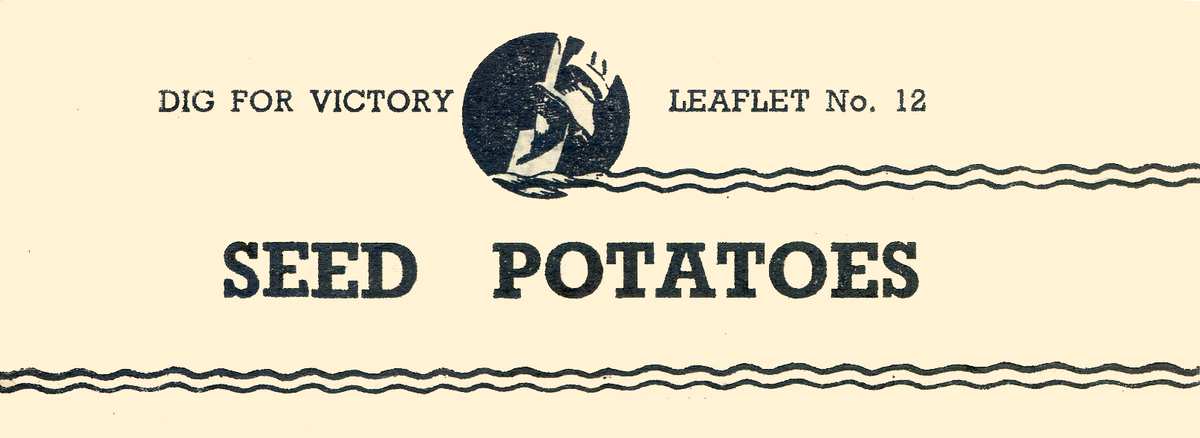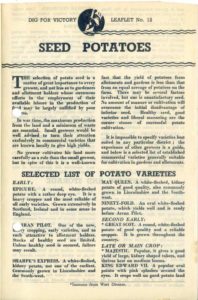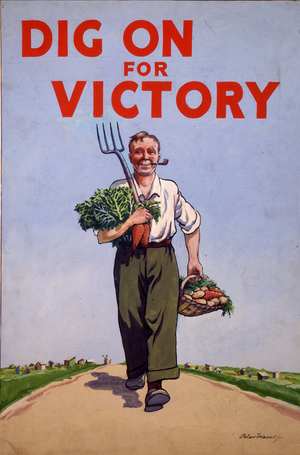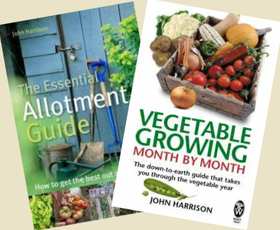 The selection of potato seed is a matter of great importance to every grower, and not less so to gardeners and allotment holders whose strenuous efforts In the employment of their available leisure in the production of food may be largely nullified by poor returns.
The selection of potato seed is a matter of great importance to every grower, and not less so to gardeners and allotment holders whose strenuous efforts In the employment of their available leisure in the production of food may be largely nullified by poor returns.
In war time, the maximum production from the land and a minimum of waste are essential. Small growers would be well advised to turn their attention exclusively to commercial varieties that are known locally lo give high yields.
No grower cultivates his land more carefully as a rule than the small grower, but in spite of this it is a well-known fact that the yield of potatoes from allotments and gardens is less than that from an equal acreage of potatoes on the farm.
There may be several factors involved, but one is unsatisfactory seed. No amount of manure or cultivation will overcome the initial disadvantage of Inferior seed. Healthy seed, good varieties and liberal manuring are the corner stones of successful potato cultivation.
It is impossible to specify varieties best suited to any particular district ; the experience of other growers is a guide, and below is a selected list of established commercial varieties generally suitable for cultivation in gardens and allotments.
SELECTED LIST OF POTATO VARIETIES
EARLY:
EPICURE. A round, white-fleshed potato, with a rather deep eye. It is a heavy cropper and the most reliable of all early varieties. Grown extensively in Scotland, Ireland and in some areas in England.
ARRAN PILOT. One of the new, heavy cropping, early varieties, and as such attractive to allotment holders. Stocks of healthy seed are limited. Unless healthy seed is secured, failure may result.
SHARPE’S EXPRESS. A white-fleshed, kidney potato, not one of the earliest. Commonly grown in Lincolnshire and the South-west.
MAY QUEEN. A white-fleshed, kidney potato of good quality, also commonly grown in Lincolnshire and the Southwest.
NINETY-FOLD. An oval white-fleshed potato, which yields well and is ready before Arran Pilot.
SECOND EARLY:
* GREAT SCOT. A round, white-fleshed potato of good quality and a reliable cropper. It is grown throughout the country.
LATE OR MAIN CROP:
* MAJESTIC. Popular, it gives a good yield of large, kidney shaped tubers, and thrives best on medium loams.
KING EDWARD VII. A popular oval potato with pink splashes around the eyes. It crops well on good potato land and is grown extensively in the Fens. Not a good cropper on the poorer classes of land.
* ARRAN BANNER. A round, flattened, white-fleshed potato. One of the heaviest cropping potatoes in cultivation. As the variety begins to form tubers early in its growth, it can be treated us either a second early or a late variety.
* GLADSTONE. Equal to King Edward in cropping. Oval in shape and same skin colour as King Edward. Outstanding cooking quality.
* KERR’S PINK. A very heavy cropper. Good keeper and of good cooking quality.
* REDSKIN. Similar to Kerr’s Pink, but matures three weeks earlier and is not quite so coarse.
UP-TO-DATE. An oval, white main-crop. For long the most popular potato in cultivation. A very heavy cropper of excellent quality. Rather more liable to Blight than some varieties.
* ARRAN VICTORY. Though the skin of the tubers is blue, the flesh is white and of excellent cooking quality. A late variety and a good cropper.
* ARRAN PEAK. Early maincrop, white oval tubers of regular shape ; satisfactory crop.
* DUNBAR STANDARD. Late main-crop, white kidney tubers of regular shape. Heavy cropper. Excellent quality.
* Immune from Wart Disease.
Synonyms
Varieties of seed potatoes bearing uncommon names are often attractive to small growers, especially if they are recommended as possessing special qualifications, such as earliness, heavy cropping, etc.
Such varieties are frequently nothing more than established commercial varieties catalogued under another name, and they are then known as synonyms.
A few examples of synonyms are as follows: Midlothian Early is the same as the standard variety Duke of York; Sir John Llewellyn is the same as Eclipse ; Cherub is Duke of York, etc.
Growers are recommended to avoid buying varieties with fancy names and to chase only the well-known varieties whose worth has been proved by long experience.
The identification of varieties from tubers is exceedingly difficult, but all varieties can be identified when growing. The Ministry, in conjunction with the National Institute of Agricultural Botany, has for years carried out identification trials, and any prospective purchaser may ascertain the particulars of any variety by writing to the Ministry.
It’s interesting to look at the potato varieties listed and see what has not survived through to today:
MAY QUEEN, NINETY-FOLD, GREAT SCOT, ARRAN PEAK, GLADSTONE, REDSKIN are all no longer listed.
I believe King Edward VII is the same potato we know as just King Edward
Synonyms were basically eliminated by the introduction of the National Seed List in the 1970s Sadly this also resulted in the loss of hundreds of seed varieties, particularly regional variations of varieties that failed to pass the overly-stringent tests of “distinctness”, “uniformity”, and “stability”.
Potato wart disease is no longer the major problem it was in the 1940s due to resistant varieties and controls over planting susceptible varieties in affected areas. This publication from DEFRA refers.
HANDLING AND STORAGE
 Seed potatoes should be handled carefully. If the skin is damaged, even only slightly, the tubers are liable to go rotten during sprouting. Seed potatoes should be examined periodically, and those showing any sign of disease should be destroyed.
Seed potatoes should be handled carefully. If the skin is damaged, even only slightly, the tubers are liable to go rotten during sprouting. Seed potatoes should be examined periodically, and those showing any sign of disease should be destroyed.
Eelworm is a pest which may become very serious if potatoes are grown too frequently on the same soil. It may occasionally be carried with the seed. The danger of its introduction to new ground may be avoided by washing the seed under a jet of cold water to remove all soil.
Care must be taken not to injure the sprouts, and if not planted immediately the sets should be dried carefully.
As soon as seed potatoes are received, they should, if possible, be placed in shallow boxes with the crown or rose end upwards. The boxes should then be placed in a cool dry shed where light in freely admitted and frost excluded. In severe weather, the seed should be covered with straw or other protective material against frost damage but the covering should be removed immediately there is no danger from frost.
Potatoes sprouted in this way produce the short sturdy shoots that make for earliness and high yield.
Two strong shoots on a tuber are sufficient unless it is intended to cut them, in which event there should be sufficient shoots, two for each cut portion. All weak shoots should be removed, and sets that produce long weak shoots under the conditions described above should be rejected altogether.
CUTTING TUBERS
During the war period there is an increased demand for high quality seed potatoes and it is inevitable that some of the seed will be of a large size.
These larger tubers will give a higher yield per plant and should, if planted whole, be set further apart than the customary 15 in. for normal sets. These large tubers may be cut, and the yield from the pieces will be considerably greater than from the same tuber uncut. It is not usual to cut sets of the normal ” hen’s egg ” size.
Objections are sometimes raised to cutting tubers on the ground that a large number of ” misses” may result. If the following precautions are taken, there need be no more ” misses ” from planting out sets than from planting whole tubers.
The stock must be healthy, and the tubers should he sprouted sufficiently to ensure that each cut portion possesses one or more vigorous sprouts. The tubers are best cut lengthwise, and care should be taken not to damage healthy eyes or sprouts.
The cut sets most not be allowed to become dry during the first 24 hours. They should not be exposed to sun or wind, nor should they be dusted with lime, slag or ashes, all of which have a drying effect which prevents healing of the cut surfaces.
The safest procedure, therefore, is to cut the tubers in a reasonably cool shed or building, or, failing this, in the shade. The cut tubers should be covered at once with a damp sack or cloth. Another method is to make the cut so that it does not go right through the tuber, but leaves a small bridge at the heel end. The two halves then remain together, preventing too rapid drying of the cut surface and they are then easily broken apart at planting time.
Having observed these conditions, the cut sets may be planted immediately, or stored until it is convenient to plant.
If the sets are planted immediately, they should not be allowed to lie exposed to drying conditions before they are covered, but the soil should be drawn over them as quickly as possible. It is best to avoid immediate planting if the soil is unduly dry, and store for a few days to allow the cut surface to heal, planting soon after rain.
Drying or heating must be avoided during storage. Satisfactory storage conditions are essential, and these may conveniently be obtained by replacing the half tubers in the sprouting boxes and leaving them in a cool room or shed.
Some varieties appear to be more susceptible to drying conditions than others, but with good management any variety may be cut successfully. This applies particularly to large tubers which can withstand adverse conditions, when cut, more successfully than small tubers. The cutting of these large tubers may be regarded as the most efficient method of planting.
SALE OF SEED POTATOES
The buyer of seed potatoes has a statutory right to a written statement giving the name and address of the seller, the ” Class,” name of variety, size and dressing of the potatoes, and the number of the Official Certificate.
Class. ” Class 1 (Scotch) ” and “Class 1 (Irish),” mean potatoes grown in Scotland and Ireland respectively. “Class 1 {English Special Stock) ” and ” Class 1 (Welsh Special Stock), mean potatoes grown in England and Wales respectively under the provisions of a scheme authorized by the Minister.
Class 1 (English once-grown) ” means potatoes grown in England and Wales which are (a) the produce of seed grown in Scotland and Ireland in the preceding year, or (b) the produce of seed included in the special Stock classes in the preceding year, such produce not being grown in accordance with a scheme authorized by the Minister. “Class 2 ” means all other potatoes.
Variety.
Variety must be true of 97 per cent, of the quantity sold. If the purity is lees than 97 per cent., seed potatoes must be sold as ” mixed varieties.”
Size and Dressing. Size of mesh of “top” and “bottom” riddle. Where potatoes are sold with the description ” as grown,” the size of the bottom riddle only need be stated.
The most economical seed potato is about the size of a hen’s egg. It is not always possible to procure the ideal size, but vendors keep within their statutory obligations so long as the tubers conform to the riddle sixes they are required to declare, e.g., 11/4 in, by 21/4 in., which means that the potatoes will remain on a 11/4 in. riddle, but will pass through a 21/4 in. one.
Official Certificates.
The Wart Disease of Potatoes Order, 1941, requires that all potatoes sold for planting must have been officially certified as having been inspected whilst growing and found to be up to the official standards of purity and health.
If potatoes are; sold for planting in a Protected Area, they must also have been officially certified us having been grown on land free from Wart Disease.
To meet present emergency conditions, general licences have been issued authorizing :—
(a) the planting or sale for planting in 1942 outside the Protected Area of any uncertified potatoes grown in the United Kingdom.
(b) the planting or sale for planting in 1942 within the Protected Area of any uncertified
potatoes grown therein which are Class 1 (English once-grown) potatoes.
Growers arc nevertheless strongly advised in their own interest to give preference, when purchasing seed potatoes, to stocks that have been officially certified or are otherwise known to come from satisfactory stocks.
Potatoes that are not of an approved immune variety must not be planted in land on which Wart Disease has occurred at any time.
SEED SAVING
Seed potato production is a specialist’s job, and it is worth while to buy good quality seed.
In the southern half of England virus diseases are spread so rapidly by greenfly that the practice of waving seed-size tubers from the garden potato crop is unsatisfactory and unwise. It is preferable to buy new seed every year. English once-grown seed with a health certificate should give yields practically as good as new Scotch seed and should be cheaper to buy.
On the other hand, in the northern and western parts of England, where greenfly are less abundant, it is usually worth while to save the seed tubers from a stock of good Scotch or Irish seed for replanting the following year.
It is only when the whole plot is healthy and vigorous and in seasons when greenfly is scarce that it is worth while to save seed. One golden rule in selecting seed potatoes is to choose the few tubers of seed size that are attached to a plant carrying a heavy crop of large tubers.
Seed should never be saved from a plot in which there are even a few poor diseased plants. Not only do the diseased plants give mainly seed-size tubers which come up diseased again the next year, but the disease has usually also been spread by greenfly to neighbouring healthy plants.
Seed of early varieties lifted while the haulm is still green may often be saved for growing a second year.
When seed of maincrop varieties is to be saved it is worth while to cut off the tops, while still green, by the middle of September, leaving the tubers in the soil for 10-14 days to allow the skins to set before lifting.
Issued by the Ministry of Agriculture and Fisheries, Hotel Lindum – St. Annes-on-sea – Lancashire
Dated February 1943


